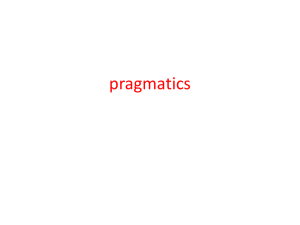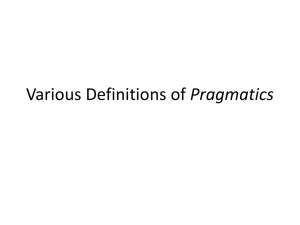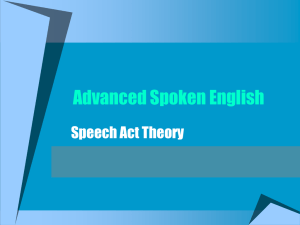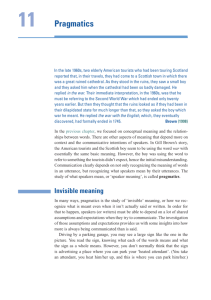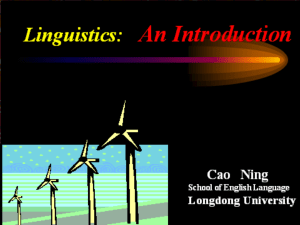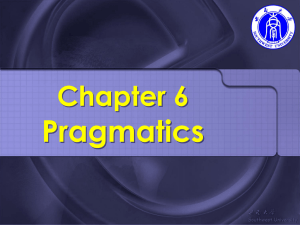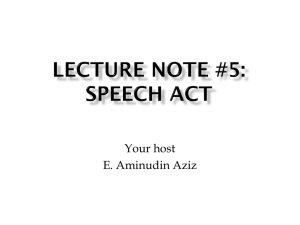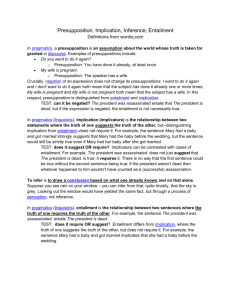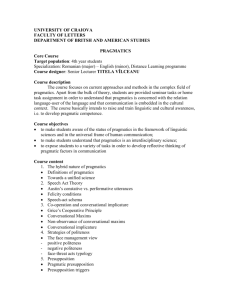Index - PRAGMATICS
advertisement
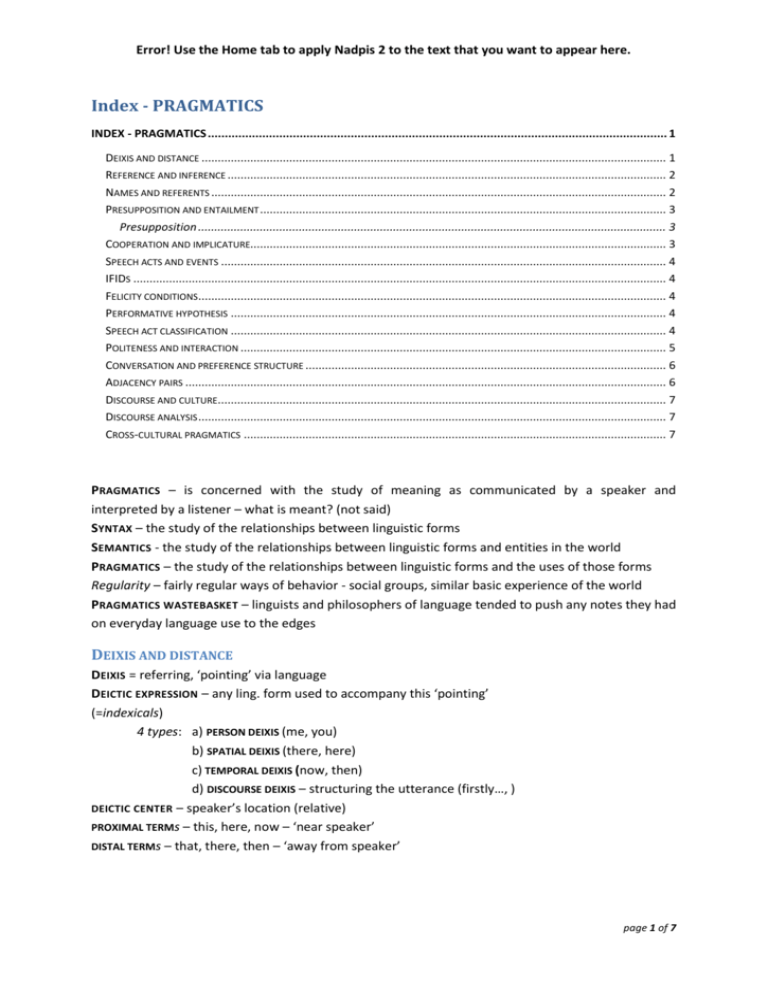
Error! Use the Home tab to apply Nadpis 2 to the text that you want to appear here. Index - PRAGMATICS INDEX - PRAGMATICS ....................................................................................................................................... 1 DEIXIS AND DISTANCE ............................................................................................................................................... 1 REFERENCE AND INFERENCE ....................................................................................................................................... 2 NAMES AND REFERENTS ............................................................................................................................................ 2 PRESUPPOSITION AND ENTAILMENT ............................................................................................................................. 3 Presupposition ................................................................................................................................................ 3 COOPERATION AND IMPLICATURE................................................................................................................................ 3 SPEECH ACTS AND EVENTS ......................................................................................................................................... 4 IFIDS .................................................................................................................................................................... 4 FELICITY CONDITIONS................................................................................................................................................ 4 PERFORMATIVE HYPOTHESIS ...................................................................................................................................... 4 SPEECH ACT CLASSIFICATION ...................................................................................................................................... 4 POLITENESS AND INTERACTION ................................................................................................................................... 5 CONVERSATION AND PREFERENCE STRUCTURE ............................................................................................................... 6 ADJACENCY PAIRS .................................................................................................................................................... 6 DISCOURSE AND CULTURE.......................................................................................................................................... 7 DISCOURSE ANALYSIS ................................................................................................................................................ 7 CROSS-CULTURAL PRAGMATICS .................................................................................................................................. 7 PRAGMATICS – is concerned with the study of meaning as communicated by a speaker and interpreted by a listener – what is meant? (not said) SYNTAX – the study of the relationships between linguistic forms SEMANTICS - the study of the relationships between linguistic forms and entities in the world PRAGMATICS – the study of the relationships between linguistic forms and the uses of those forms Regularity – fairly regular ways of behavior - social groups, similar basic experience of the world PRAGMATICS WASTEBASKET – linguists and philosophers of language tended to push any notes they had on everyday language use to the edges DEIXIS AND DISTANCE DEIXIS = referring, ‘pointing’ via language DEICTIC EXPRESSION – any ling. form used to accompany this ‘pointing’ (=indexicals) 4 types: a) PERSON DEIXIS (me, you) b) SPATIAL DEIXIS (there, here) c) TEMPORAL DEIXIS (now, then) d) DISCOURSE DEIXIS – structuring the utterance (firstly…, ) DEICTIC CENTER – speaker’s location (relative) PROXIMAL TERMs – this, here, now – ‘near speaker’ DISTAL TERMs – that, there, then – ‘away from speaker’ page 1 of 7 Error! Use the Home tab to apply Nadpis 2 to the text that you want to appear here. a) T/V DISTINCTION (tu/vous), HONORIFICS Exclusive ‘we’ – speaker + other(s), excluding addressee Inclusive ‘we’ – speaker + addressee included b) come – to the speaker / go – away from speaker DEICTIC PROJECTION – speakers project themselves to a certain location when temporarily away PSYCHOLOGICAL DISTANCE – can mark something far away as ‘here’ and st close as ‘that’ TENSES AND TIME: PROXIMAL – present tense – closeness DISTAL – past tense – distance TENSE X Present Past TIME present present (distance, hypothetical – If I were you…) Past past Present past (historical present, story-telling, jokes) Would – hyp / will – real If I had (past tense – hypothetical) money, I would (distal, hypothetical) buy (present=now) it. REFERENCE AND INFERENCE REFERENCE – act in which addresser uses linguistic forms to enable addressee to identify something REFERRING EXPRESSIONS – proper nouns (Shakespeare), definite noun phrases (the author) or indefinite (a man), and pronouns (she) INFERENCE (dedukce) – listener must be able to correctly understand which entity the speaker identifies by particular referring expression ATTRIBUTIVE USE – ‘He wants to marry a woman with lots of money.’ – ‘a’ can be replaced by ‘any’ – meaning ‘whoever fits the description REFERENTIAL USE – certain person in mind NAMES AND REFERENTS Person identified via ‘the cheese sandwich’, thing via ‘Shakespeare’ PRAGMATIC CONNECTION – between proper names and objects associated ‘Brazil wins World Cup.’ CO-TEXT – linguistic material accompanying the referring expression (wins World Cup) RANGE OF REFERENCE – provided by ref. expression, it is a number of possible referents > different cotext leads to different interpretation CONTEXT – the physical environment (‘Your ten-thirty just cancelled.’ = person) ANAPHOR – the second or subsequent expression to already introduced referents ANTECEDENT – the initial expression CATAPHORA – when pronoun ‘it’ is used first and is difficult to interpret until fully explained ZERO ANAPHORA (ELLIPSIS) – ‘Cook (?) for three minutes.’ – no linguistic expression is present page 2 of 7 Error! Use the Home tab to apply Nadpis 2 to the text that you want to appear here. PRESUPPOSITION AND ENTAILMENT PRESUPPOSITION (předpoklad) – that what speaker assumes is the case prior to making an utterance (‘Mary’s brother died.’ – pres. - a person Mary exists, she has a brother ) ENTAILMENT – something that logically follows from what is asserted in the utterance Presupposition -relationship between two propositions: Mary’s dog is cute. (=p) Mary has a dog. (=q) p>>q Mary’s dog isn’t cute. (= NOT p) Mary has a dog. (=q) NOT p>>q TYPES: POTENTIAL PRES. – can only become actual presupposition in contexts with speakers. EXISTENTIAL PRES. – possessive construction is associated with a pres. of existence. FACTIVE PRES. – pres. information after a verb like ‘know’ can be treated as a fact LEXICAL PRES. – one form with a meaning presupposes another meaning is understood STRUCTURAL PRES. – part of the sentence structure is already assumed to be true NON-FACTIVE PRES. – assumed not to be true (‘dream’, ‘imagine’,…) COUNTER-FACTUAL PRES. – what is presupposed is the opposite of what is true PROJECTION PROBLEM – the meaning of some presuppositions doesn’t survive to become meaning of some complex sentences ENTAILMENT (a necessary consequence of what is said) is simply more powerful than the presupposition BACKGROUND ENTAILMENTS – they appear when a speaker utters a sentence FOREGROUND ENTAILMENT – typically by stress – the speaker communicates which entailment is assumed to be in the foreground STRESS FUNCTION similar to it-cleft construction ‘It was ROVER that chased the squirrels.’ COOPERATION AND IMPLICATURE TAUTOLOGIES – apparently pointless expressions (Boys will be boys) – speaker intends to communicate more than is said IMPLICATURE – additional conveyed meaning than just what the words mean COOPERATIVE PRINCIPLE – the assumption of cooperation, elaborated into 4 sub-principles> MAXIMS – of quantity, quality, relation, manner a) QUALITY – be true, do not say st false / measured by the number of expressions we use to indicate not certainty ( As far as I know, I guess, …) – cautious notes = HEDGES > b) QUANTITY – as informative as required, don’t make it more informative than is required /(So, to cut long story short, we started to run.) c) RELATION – be relevant / markers of relevance level ‘Oh, by the way’ – mention something not relevant d) MANNER – be brief, be orderly, avoid ambiguity,… / ‘I’m not sure if this makes sense’ page 3 of 7 Error! Use the Home tab to apply Nadpis 2 to the text that you want to appear here. SPEECH ACTS AND EVENTS SPEECH ACTS – actions performed via utterances SPEECH EVENTS – circumstances surrounding the utterance that help both speaker and hearer in the process of communication SPEECH ACTS the action performed by producing an utterance will consist of three related acts: a) LOCUTIONARY ACT – the basic act of utterance – producing meaningful linguistic expression b) ILLOCUTIONARY ACT (il. force) – we form an utterance with some kind of function in mind c) PERLOCUTIONARY ACT (per. effect) – we create an utterance so the hearer will recognize the effect we indended ILLOCUTIONARY FORCE most important IFIDS Illocutionary Force Indicating Device PERFORMATIVE VERB (Vp) – verb that explicitly names the illocutionary act performed ‘I (Vp) you that…’ > promise, warn FELICITY CONDITIONS certain expected or appropriate circumstances for the performance of a speech act to be recognized as intended GENERAL CONDITIONS – preconditions on speech acts (e.g. that you can understand the language) CONTENT CONDITIONS – e.g. for both a promise and a warning the content of the utterance must be about a future event PREPARATORY CONDITIONS – for a promise are significantly different from those of a warning SINCERITY CONDITIONS – the speaker intends to perform certain actions (promise/warning) ESSENTIAL CONDITIONS – the utterance changes my state from non-obligation (promise) or noninforming (warning) to obligation or informing PERFORMATIVE HYPOTHESIS =underlying every utterance (U) there is a clause containing a performative verb (Vp) which makes the illocutionary force explicit – ‘I (hereby) Vp you (that) U.’ EXPLICIT (strict) vs IMPLICIT (not clear – warning/order/…) PERFORMATIVES SPEECH ACT CLASSIFICATION a) b) c) d) e) DECLARATIONS – ‘I now pronounce you husband and wife.’ REPRESENTATIVES – ‘The earth is flat.’ EXPRESSIVES – ‘I’m really sorry!’ DIRECTIVES – ‘Don’t touch that!’ COMMISSIVES – ‘I’ll be back.’ page 4 of 7 Error! Use the Home tab to apply Nadpis 2 to the text that you want to appear here. Relationship of structural forms and communicative functions: a) DECLARATIVE – statement “You wear a seat belt.” b) INTERROGATIVE – question “Do you wear a seat belt?” c) IMPERATIVE – command/request “Wear a seat belt!” - direct relationship = DIRECT SPEECH ACT (It’s cold outside – statement) - indirect relationship = INDIRECT SPEECH ACT (It’s cold outside > close the window – request) SPEECH EVENT – an activity in which participants interact via language in some conventional way to arrive at some outcome POLITENESS AND INTERACTION -social distance vs. closeness POLITENESS -idea of ‘polite social behavior’ within a culture FACE – the public self-image of a person, the emotional and social sense of self that everyone has and expects everyone else to recognize POLITENESS – the means employed to show awareness of another person’s face FACE WANTS – the public self-image, people want it to be respected FACE THREATENING ACT – a threat to another individual’s expectations regarding self-image FACE SAVING ACT – something said by the speaker to lessen the possible threat NEGATIVE FACE – the need to be independent, to have freedom of action and not to be imposed on by others POSITIVE FACE – is the need to be accepted by others, to be treated as a member of the same group and to know that his or her wants are shared by others NEGATIVE POLITENESS – a face saving act which is oriented to the person’s negative face, will tend to show deference, emphasizing the importance of other’s time or concerns POSITIVE POLITENESS – a face saving act which is concerned with the person’s positive face, will tend to show solidarity, emphasizing that both speakers want the same thing OFF RECORD (Uh, I forgot my pen) vs ON RECORD (Give me a pen – BALD ON RECORD ) ‘please’, ‘would you?’ – MITIGATING DEVICES POSITIVE vs. NEGATIVE POLITENESS STRATEGY (“Hey, buddy, I’d appreciate it if you’d let me use your pen.” Vs. “Could you lend me a pen?”) SOLIDARITY STRATEGY – ‘we’, ‘let’s’ vs. DEFERENCE STRATEGY ( FORMAL POLITENESS ) – impersonal page 5 of 7 Error! Use the Home tab to apply Nadpis 2 to the text that you want to appear here. CONVERSATION AND PREFERENCE STRUCTURE -the most widely used analytic approach is based on an analogy with the workings of a market economy: FLOOR – right to spook TURN – having control of this at any time TURN-TAKING – in any situation where control is not fixed in advance, anyone can attempt to get control LOCAL MANAGEMENTS SYSTEM – it is known by members of a social group, turn-taking operates in accordance with it OVERLAP – both speakers trying to speak at the same time – can be harmonic or competing ATTRIBUTABLE SILENCE – when one speaker turns over the floor to another and the other does not speak – silence is attributed to the second speaker and becomes significant BACKCHANNEL SIGNALS (BACKCHANNELS) – the indication that the listener listens to the speaker, e.g. ‘uh-uh’, ‘yeah’, ‘mmm’ – indicate that the listener is following and not objecting CONVERSATIONAL STYLE HIGH INVOLVEMENT STYLE vs. HIGH CONSIDERATENESS STYLE o (active conversation, fast speaking rate, no pause between turns vs. slow, do not overlap,…) ADJACENCY PAIRS almost automatic patterns in the structure of conversation (“How are you?” “Fine.”) always consist of a FIRST PART and a SECOND PART , produced by different speakers TYPES: o o o o OPENING SEQUENCES – “How ya doin’?” “Can’t complain.” QUESTION-ANSWER SEQUENCE – “What time is it?” “About eight-thirty.” THANKING-RESPONSE – “Thanks.” “You’re welcome.” REQUEST-ACCEPT – “Could you help me with this?” “Sure.” INSERTION SEQUENCE – one question-answer sequence intervenes first Q-A sequence (Q1-Q2-A2-A1) PREFERENCE STRUCTURE – a first part (request/offer) is made in the expectance that the second part will be an acceptance.; an acceptance is structurally more likely than a refusal = PREFERENCE divides second parts (disagree/refuse/decline) SILENCE into PREFERRED (agree/accept) and DISPREFERRED in the second part – indication of a disprefered response – often leads the first speaker to revise the first part to get a second part page 6 of 7 Error! Use the Home tab to apply Nadpis 2 to the text that you want to appear here. DISCOURSE AND CULTURE language: INTERPERSONAL FUNCTION – taking part in social interaction TEXTUAL FUNCTION – creating well-formed and appropriate text IDEATIONAL FUNCTION – representing thought and experience in a coherent way DISCOURSE ANALYSIS focuses on the record (spoken or written) of the process by which language is used in some context to express intention Pragmatic side focuses specifically on aspects of what is unsaid or unwritten, yet communicated COHERENCE – what is said or written will make sense in terms of speaker’s normal experience of things; emphasis on familiarity and knowledge we often tend not to see possible alternatives, we automatically fill in detail to create coherence SCHEMA (plural SCHEMATA) - a pre-existing knowledge structure in memory o fixed, static pattern to the schema – FRAME (apartment – kitchen, bathroom and bedroom) o SCRIPT – more dynamic type of schema, a pre-existing knowledge structure involving event sequences CULTURAL SCHEMATA – are developed in the contexts of our basic experiences CROSS-CULTURAL PRAGMATICS includes the study of differences in expectations based on cultural schemata CONTRASTIVE PRAGMATICS – the study of different cultural ways of speaking INTERLANGUAGE PRAGMATICS – focus on the communicative behavior of non-native speakers, attempting to communicate in their second language PRAGMATIC ACCENT – aspects of our talk that indicate what we assume is communicated without being said page 7 of 7
